The Evolution of the Female Physique
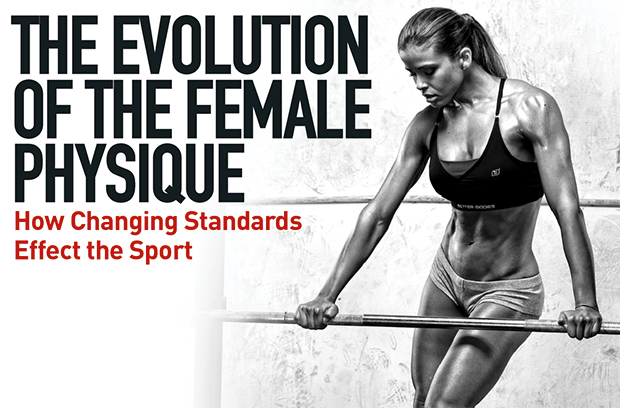
How Changing Standards Effect the Sport
On any given weekend across the country, hundreds of females step onstage in small, rhinestone-covered posing suits and hit their mandatory poses under the scrutinizing eye of a panel of judges. These women are judged purely on their aesthetics and compared directly to one another during their time onstage. As the competition moves through different categories from bikini, to fitness, to figure, to women’s physique to women’s bodybuilding, the physiques of the women change and get more muscular and ripped to the bone. To those in the audience who are unfamiliar with the world of physique contests, it may be confusing.
The world of female bodybuilding has evolved a lot over the last 40 years, from its inception, when the sport consisted of just one category, to its current structure with five professionally recognized categories (bikini, fitness, figure, bodybuilding, and physique). Women are now able to build their ideal physiques and see how they rank. However, even within these five categories, there have been dramatic changes in the size and conditioning of athletes. As the landscape of the sport continues to evolve, one question remains: Is the evolution taking the sport in the right direction?
The History of Female Bodybuilding
While it’s generally always been acceptable for men to be muscular and flaunt their physiques, this acceptance of females has been much slower. Men’s competitive bodybuilding has roots tracing back to the early 1900s, when the first bodybuilding contest was held with much success. Approximately 50 years later, these contests saw the addition of a female component, but it was more in line with a beauty pageant than a celebration of female strength.
That began to change in the late 1970s, when the first competition was held in which women were judged solely on their muscular development, symmetry, and physique presentation. The very first Ms. Olympia took place in 1980, and by 1982, women’s bodybuilding was officially recognized by the International Federation of Bodybuilding and Fitness (IFBB), the governing body of the sport.
Up to this point, there was one category for female competitors, but that soon changed when the first fitness competition took place in 1985. This contest saw females competing in three rounds—mandatory physique posing, an athletic routine, and the evening gown, which helped boost the feminine appeal of physique competitions. Almost ten years after women’s bodybuilding debuted, the IFBB added the Fitness Olympia title in 1995, which would mark the start of the growth of the sport.
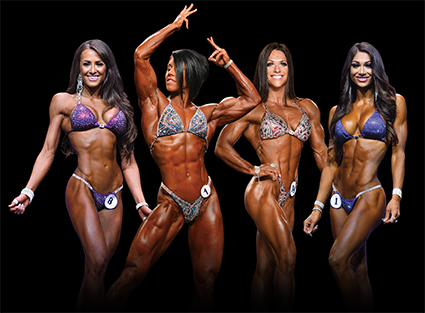
Exponential Growth
The addition of the fitness category was well received by the masses. Following fitness, the figure category was introduced in 2003. With the popularity of fitness came the need to host a similar category, but without the demand of the aerobic routine: a category for women who wanted to build muscle but lacked the gymnastics and/or dance experience for the routine. Physiques in this category were to be athletic, lean, and presented with feminine grace and poise. The IFBB dictated that these competitors should have shape to their muscles, but not be excessively large or lean, lacking deep separation.
Bikini Class (2011)
Possibly the most mainstream category, “bikini” debuted upon the professional stage in 2011 to a great reception. The bikini class showcases a much more marketable and attainable physique for females—fit, lean, and curvy, with sex appeal thrown in. Judging criteria specifies that the physique should be firm with decreased body fat, but not excessively muscular or lean, and free from muscle separations. Additionally, the women are judged on their skin tone, hair, and facial beauty, along with the way they present themselves. These physiques are similar to what is seen on the covers of popular fitness magazines across the nation.
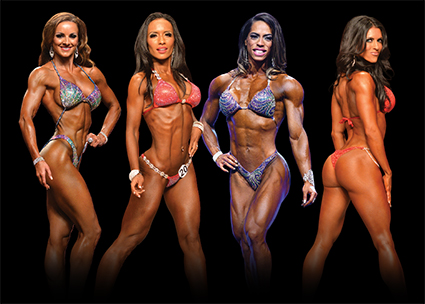
Women’s Physique (2012)
The newest kid on the block is women’s physique (WP). This category was unveiled on the pro stage in 2012 to bridge the gap between figure and bodybuilding. The creation of this division provided a platform for women who liked to build muscle but didn’t want to build the mass required for bodybuilding. Those competing in WP are judged on their muscle tone and size, symmetry, level of leanness, and the femininity of their physiques. It has been noted that “excessive muscularity” would be scored down accordingly. In short, these competitors come in with similar aesthetics to figure, but with more muscle mass and a leaner physique.
Over the span of nine years, the female divisions of the IFBB grew rapidly, adding three new categories. This growth has expanded the industry, providing an avenue for many body types and training styles with the opportunity to compete. However, evolution within these classes has also occurred, and the sport has witnessed growth in another way—in the athlete’s physiques.
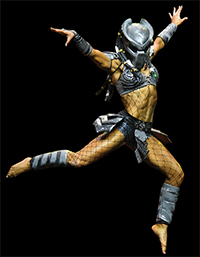 Physique Evolution
Physique Evolution
At the start, female bodybuilders weren’t overly large. In fact, many of the trendsetters of the sport, such as Rachel McLish and Carla Dunlap, would look more at home as figure competitors by current standards. When athletes such as Cory Everson and Bev Francis took to the stage, they had a harder time placing due to their shocking amount of muscle mass. Judges rewarded smaller (albeit still quite muscular), more feminine aesthetics such as those of Anja Schreiner. The battle between size and femininity has been present in the sport since its inception, consistently challenging athletes and judges to find the ideal balance.
Over the last 20 years, females in bodybuilding have evolved at an incredibly rapid rate. A simple comparison of pictures from the start of any category to current competitors exemplifies the evolution of the female physique. Across the board, the athletes are looking leaner, harder, and more muscular. Athletes in other, more mainstream sports have a variety of objective goals to make progress: They can run a race faster, hit a ball farther, or add a more difficult element to a routine for a higher score. In the world of bodybuilding, pushing the body further is done by building more muscle or shedding a little more body fat, and the athletes in this sport are no different from others—they want to make continuous improvements to their performance.
Advances in science have helped to accelerate these changes. University labs are devoted to studying the sport’s athletes, monitoring muscle activation during training sessions, and formulating optimal training plans for growth. Seminars are held by industry experts to cover everything from training to nutrition, therapy modalities, and supplementation protocols. The advancement in knowledge is able to reach a wide population due to social media channels; it’s common for coaches to post educational tips online, paired with photos or videos to demonstrate their point. Should an aspiring athlete know where to look, she can reap serious rewards of knowledge and physique refinement … for free.
These physical changes are creating some issues for competitors as their physiques move away from how they were originally intended to look. Dana Linn Bailey, the inaugural Ms. Physique Olympia, has been quoted as saying she’s now too small to be competitive in the category, which had been perfectly suited for her when it was first introduced.
While growth and advancement is usually a positive thing, in this sport, it’s a case of history repeating itself, and can actually result in an athlete placing lower than desired.
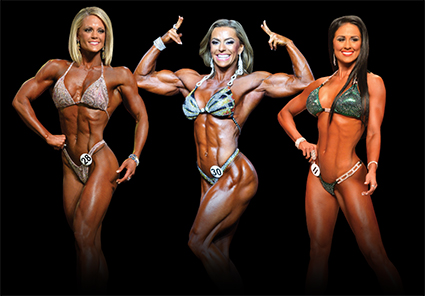
Downsizing Requests
In 2016, the IFBB announced that it would focus judging focused specifically on the level of muscularity women’s physique and figure competitors were bringing to the pro stage, trickling down to the amateur levels. The announcement stated that displaying excessive muscularity within these categories would be scored down accordingly, in an effort to maintain a feminine aspect across the sport.
However, this wasn’t the first time a request like this had been made. In fact, similar situations have taken place throughout the sport’s history. In 1992 judges’ requirements were rewritten to include and focus on feminine aesthetics in an effort to bring the attention away from extreme musculature. Later, in 2004, a memo was released with a “20 percent rule” requesting that all female athletes within the IFBB reduce their muscularity by 20 percent. The goal of these downsizing requests was to maintain a more feminine aesthetic and to protect the health of the athletes, and was speculated to help keep the sport more marketable to the population.
On June 7, 2013, the Arnold Sports Festival promoters announced that after 2014 they would be removing female bodybuilding from their event, of which it had been a part since 1986. This was a sign of things to come, and in 2014, the final Ms. Olympia was crowned. Following suit, AMI/Weider decided to also remove the female bodybuilding category from the prestigious event. The underlying message of this decision was loud and clear—“size matters”—and bodybuilding had surpassed a look with which many were comfortable.
The Outcome
The removal of women’s bodybuilding from both the Olympia and Arnold Sports Festival stages, along with a large portion of professional shows throughout the year, leaves these athletes with very few competitive options. They can retire from the sport, compete in the few remaining shows, or switch categories.
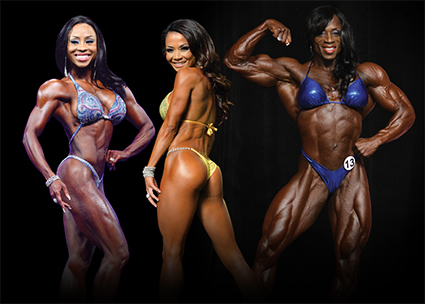
Switching Categories
If retirement isn’t a desirable option for these athletes, they’ll have to decide between the other two choices, both of which can be challenging in their own respects. Continuing to compete as a bodybuilder comes with the restriction of the small quantity of shows available to athletes. Currently, seven professional shows offer women’s bodybuilding. To put this into perspective, there are 24 competitions for male bodybuilders and 44 offering women’s bikini at the professional level! To help fill the void of the Ms. Olympia title, the show promoter who hosts the Rising Phoenix competition requires female bodybuilders to qualify through a point collection system, much as the Olympia does. While the prize money offered at this show is less than the Olympia had boasted, it’s the highest paying show of the year for these women.
Those athletes who opt to switch categories need to take the time to actively downsize their physiques. For an athlete who has spent years, even decades, building herself up, this can be a tough road to travel. It will mean a complete change in training and nutrition protocols along with a large increase in cardio sessions in an attempt to burn off hard-earned muscle mass—not an easy feat.
In what may have been a proactive approach, a handful of bodybuilders made the switch to women’s physique before the full reduction of their category took place. This movement saw a number of competitors on the women’s physique stage carrying more muscle than had been previously experienced, likely further prompting the announcement in 2015.
The Future
It’s safe to say the female divisions of the IFBB will continue to thrive in the future. Competitions at the amateur level have grown rapidly, with many national shows needing to span two days in order to schedule all the categories. As the number of female competitors grows, society’s acceptance of fit and muscular women increases. This movement has created a more positive space for women to push themselves to new physical levels and to create the physiques they desire.
While there won’t be a challenge in getting athletes onstage, the challenge lies in keeping the physiques true to their categories and not outgrowing the judging criteria.

